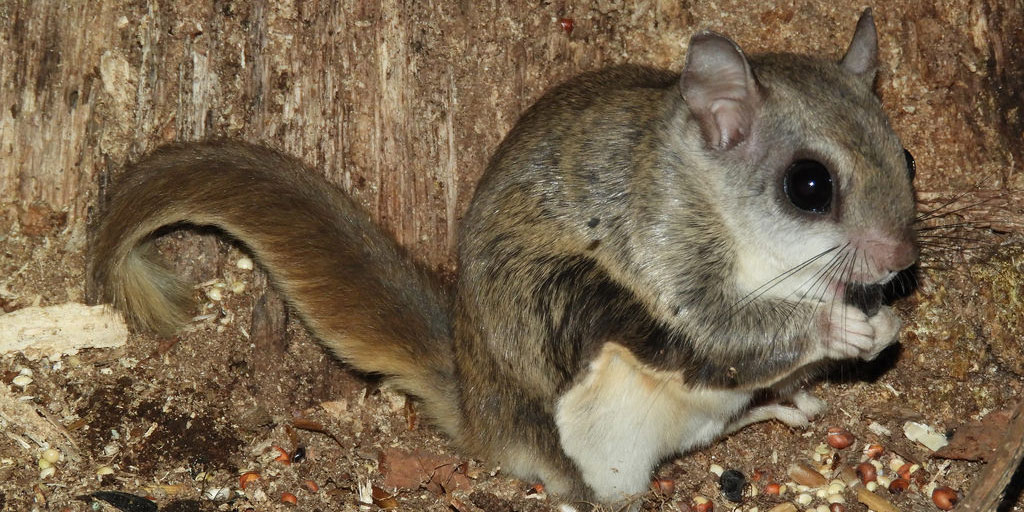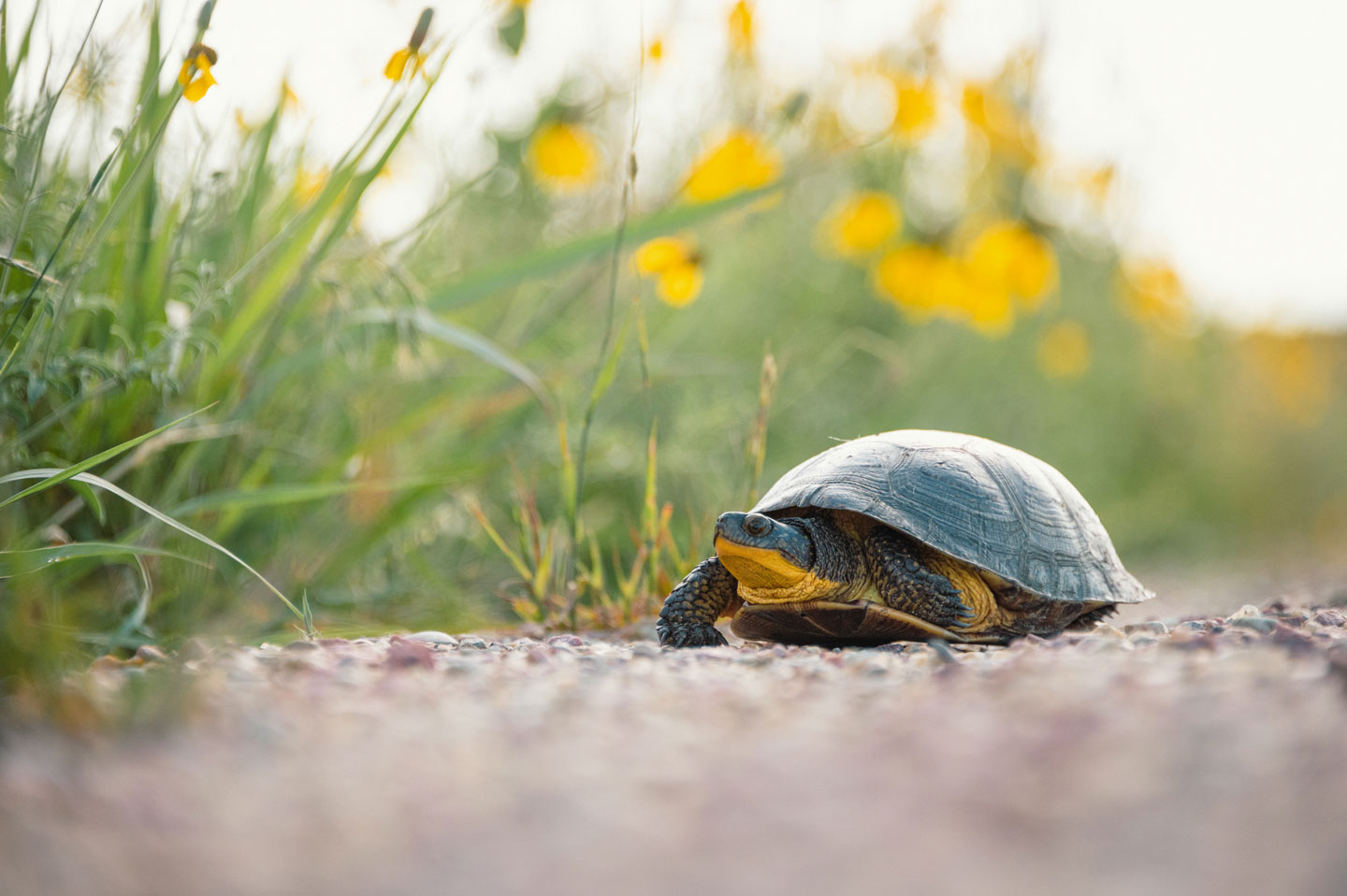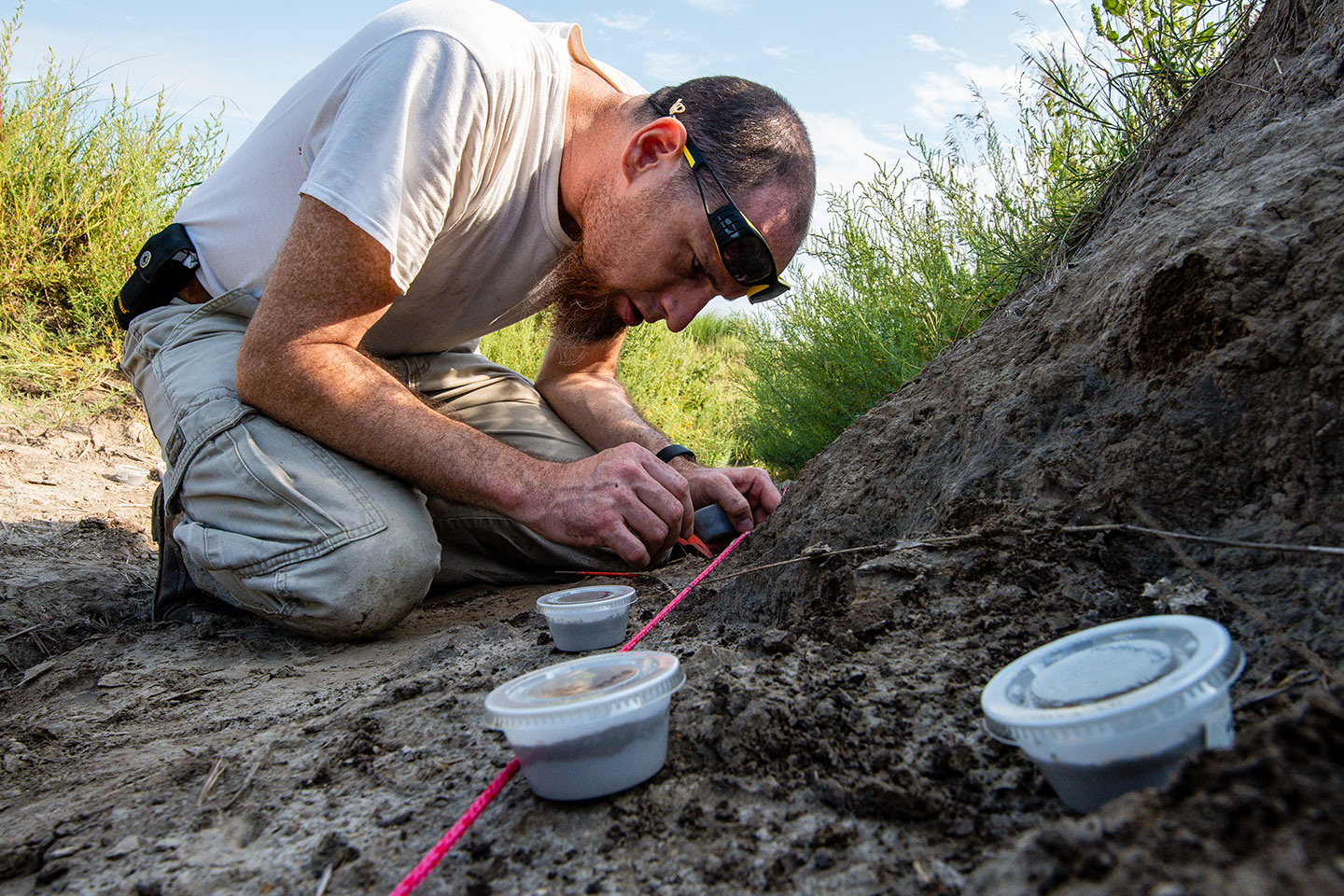Southern flying squirrel
Status: Threatened

Although common in many eastern states, the southern flying squirrel (Glaucomys volans) is considered threatened in Nebraska.
Flying squirrels have a white belly with a flattened tail used like a rudder. They are 7.8-10 inches long and weigh only 1.5-3 ounces. They are strictly nocturnal creatures known for their ability to “fly” among trees. They do not actually fly; they glide. Between each wrist of the front leg to the ankle of the hind leg there is a wing-like membrane, called a patagium. When the arms and legs are extended, the membrane forms a wing-like gliding surface.
The noticeably large eyes, an adaptation for its nocturnal habits, are surrounded by a black ring. Whiskers are prominent as are ears, which are more pronounced than in other tree squirrels. The eyes are surrounded by a black ring, and a black border extends along the edge of the gliding membrane. Their fur is soft, silky and moderately long. Fur on the wing-like membrane is shorter than on the rest of the squirrel’s body for better aerodynamics.
Flying squirrels produce several vocalizations including a high pitched “tseet” and other chirping sounds. Some vocalizations are above the frequency range of the human ear.
The “flying” or “glide” of the southern flying squirrel begin after the squirrel climbs to a lofty treetop perch and assesses the landing site by moving its head all around, apparently attempting to judge distance. It then launches itself with all four legs extended, stretching-out the gliding membrane.
With tremendous agility, flying squirrels can steer around branches or other obstacles. Most steering is done with the tail, but squirrels also vary the tension on the membrane to steer and to control speed. They usually land on the vertical trunk of another tree, invariably upright with the hind feet touching first. Upon landing, they scurry to the opposite side of the tree to elude any pursuing predator. Glides occasionally extend for more than 50 yards, but are usually much shorter.
While southern flying squirrels do not hibernate, they may remain in their nests for several days during severe winter weather. They may also form groups in a common nest to conserve warmth. The number of animals in the winter congregations varies by latitude, with larger congregations found in northern climates.
Flying squirrels seldom live more than five years in the wild. Predators include owls, domestic cats, hawks, snakes, bobcats, raccoons, weasels and foxes.
Range
The southern flying squirrel’s range extends from southeastern Canada throughout the entire eastern United States. In Nebraska, flying squirrels inhabit primarily hardwood forests along the southeastern edge of the state such as the Missouri River forests, Indian Cave Bluffs and Rulo Bluffs landscapes.
Diet
Flying squirrels are omnivores, although they eat mostly plant material. Tree nuts make up the bulk of their diet; they will also eat seeds, buds, fruit, sap, mushrooms, berries, tree bark, insects, bird eggs or nestlings, mice, and carrion. As winter approaches nuts are gathered and stored in caches.
Habitat
Flying squirrels are secondary cavity nesters, meaning they do not create their own cavities but rely on existing cavities such as old woodpecker nests and holes in trees. Flying squirrels readily use nest boxes placed for their benefit or for other species. Cavities are typically lined with strips of inner bark and leaves, but lichens, moss, feathers and other materials have been used.
Reproduction
Southern flying squirrels show two periods of breeding activity. The first is in February and March, and the other is from late May through July. Females can produce two litters per year but only under favorable conditions. Litters, usually of three or four, but up to seven young, are born following a gestation period of 40 days.
Newborn young are hairless with eyes and ears closed. They are tiny, weighing less than a quarter-ounce each. The gliding membrane is visible as a transparent fold of skin. The ears open at about three weeks of age, and a week later the eyes open. The young are weaned at six to eight weeks and are capable of gliding soon thereafter. Young typically remain with the female until the next litter is born.
Adults are sometimes seen together as pairs, but males typically leave females before the young are born and do not assist in caring for the young. Females seldom leave the new-born young, defend them vigorously and will move the young to a new nest if disturbed or to eliminate parasites.
Flying squirrels reach sexual maturity at about one year. They do not form tight pair-bonds. Females often have different mates each breeding seasons.
Population status
The primary reason the southern flying squirrel is threatened in Nebraska is the limited amount of mature, hardwood deciduous forest habitat.
Hardwood trees such as oaks and hickories produce acorns and nuts that squirrels require in large quantities to survive over the winter. Mature trees are also needed to provide the cavities or holes that squirrels need for nesting and protection. After the area was settled, many of these large trees were cut for lumber. Timber harvest still occurs periodically as trees reach mature size. This harvest removes trees that produce acorns and nuts and that provide the greatest number of cavities.
The Southern Flying Squirrel is listed as a Nebraska Threatened Species.
Management and outlook
The primary management tool used for conserving flying squirrels in Nebraska is maintaining mature forests and retaining dead trees, or trees with dead limbs, to offer roosting and nesting cavities.
Conservation help
Homeowners in southeast Nebraska should consider minimizing tree removal, erect nest boxes, and keep pets, such as house cats, from roaming freely.
Donations to conservation organizations which help with research, land and habitat conservation and education is also critical to ensuring flying squirrel populations do not decline further.
References
Adirondack Ecological Center: Adirondack Mammals. State University of New York College of Environmental Science and Forestry. 2011.
Nebraska’s At-risk Wildlife. Nebraska Game and Parks Commission. 2010.
Mammals of the Northern Great Plains. 1983. Knox Jones Jr. University of Nebraska Press.
This pamphlet is one of a series of pamphlets about Nebraska’s rare species. To learn more about Nebraska’s rare species, please visit rarespecies.nebraska.gov.
Copyright 2013. Published by the Nebraska Game and Parks Commission with funds from the Nebraska Environmental Trust.
NOTE: New data of the occurrence and distribution of this species are being collected constantly and some of the information in the pamphlet may be outdated. The information in this pamphlet should be used for a general understanding of the species and not as the sole source of range location for any report, project, regional or local planning, or for environmental impact assessments. For current information on this species, please contact the Nebraska Game and Parks Commission, Wildlife Division.




